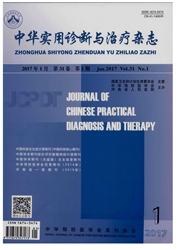

 中文摘要:
中文摘要:
目的探讨超敏C反应蛋白(hs-CRP)与2型糖尿病患者并发症的关系,炎症是否参与并发症的发生、发展。D-二聚体(D-D)、血浆血管性假性血友病因子(vWF)反映的则是血管内皮细胞的损伤程度。从而,用于2型糖尿病合并血管病变患者的早期监测,为临床提供理论依据。方法不同病程的糖尿病患者300例分成3组。每组100例,其中糖尿病合并大血管病变组(DM1)、合并微血管病变并出现尿微量蛋白组(DM:)、糖尿病无并发症组(DM3)。另取无糖尿病患者100例为正常对照组(NC)。分别检测血液中的hs-CRP、D-D、vWF浓度。结果与NC组比较DM1、DM2及DM3组hs-CRP、D-D及vWF的浓度显著增加,差异有统计学意义(P〈0.01);与DM3组比较DMI及DM2组hs-CRP、D-D及vWF的浓度显著增加,差异有统计学意义(P〈0.01)。结论hs-CRP、D-D、及vWF浓度均随合并血管病变程度的增大而升高。
 英文摘要:
英文摘要:
Objective To study the relationship between hypersensitive C-reactive protein (hs-CRP) and complications in patients with type 2 diabetes, whether inflammation was involved in the occurrence of complications, and develop- ment; whether D-dimer (D-D), plasma vascular pseudo willebrand factor (vWF) reflected the vascular endothelial cell damage degree. Thus, to use it for mellitus and monitoring of vascular lesions in patients with early type 2 diabetes, and to provide theoretical basis for clinical. Methods Three hundred cases with different duration of diabetes patients were divided into three groups, each group had 100 cases, including diabetic vascular lesion group (DM1), the merger of microvascular lesions with urinary micro protein group (DM2), diabetes without complications (DM3). Another 100 cases of patients without diabetes were chosen as normal control group (NC). the hs-CRP, D-D, vWF levels in the blood were detected. Results Compared with NC group, DM1 and DM2 and DM3 group of hs-CRP, D-D and vWF levels increased significantly, the difference was statistically significant (P 〈 0.01); compared with DM3 group, DM1 and DM2 of hs-CRP, D-D and vWF levels increased significantly, the difference was statistically significant (P 〈 0.01). Conclusion hs-CRP, D-D, and vWF concentrations are increased with the increace of combined vascular lesions.
 同期刊论文项目
同期刊论文项目
 同项目期刊论文
同项目期刊论文
 期刊信息
期刊信息
